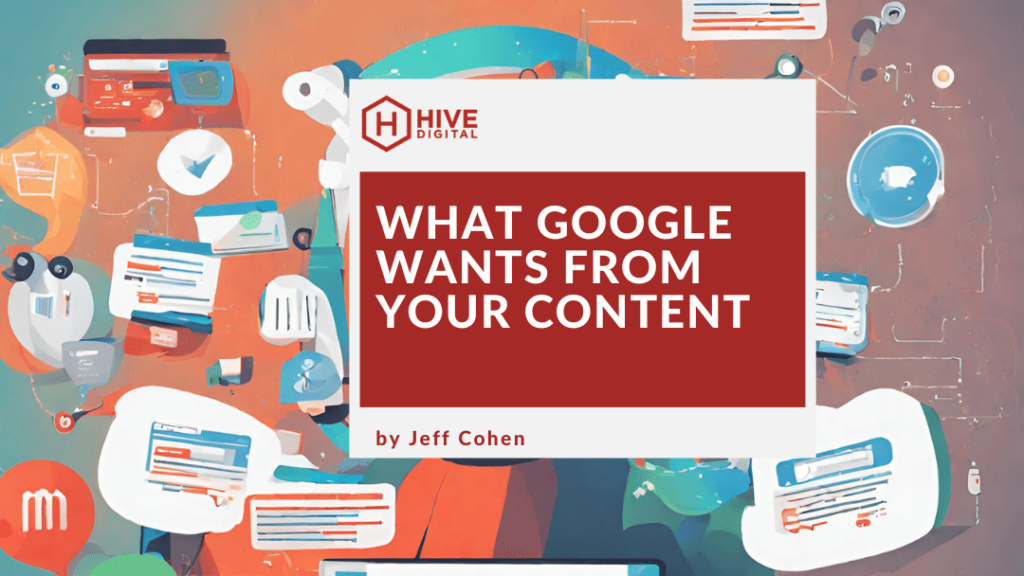When it comes to the foundation of your digital marketing efforts, content has emerged as a key element in shaping your online visibility. Whether you’re working on organic presence or Paid Search campaigns, both rely on driving someone to content that they’ll actually want to see. Since Google is the biggest player on the block, they play a significant role in influencing how businesses and marketing teams approach their content creation process. Having an understanding of what Google wants from your content can help improve your website’s visibility and ultimately help drive more qualified traffic.
So What is Google Looking for in Content?
The Short Answer… Quality Content
Despite the frequent updates to Google’s algorithm, the underlying principle guiding these changes remains constant: create compelling, high-quality content. Google’s ultimate aim is to offer its users the most relevant and valuable information in response to their search queries. This focus on a user’s experience is reflected in the various updates over the years to their ranking algorithm, which favors content that is comprehensive, accurate, and engaging. That sounds easy enough, but what exactly is “high-quality content”? Here’s where things can get nuanced. Back in the old days of SEO many people thought quality content simply meant jamming in a bunch of exact keywords (that had high search volume) into a giant wall of text would get the attention of the search crawlers and rank high. And for many it did… for a while. But as people tried to game the system with things like strategic keyword placement and keyword density, Google started making the algorithm pay closer attention and then they started to provide more details about what they were looking for.
Why is Content So Important for SEO?
If you build it, they will come. (I know, I know. The line from the movie is “he will come”). These days, creating content is not just about integrating keywords or employing advanced SEO tactics. It is about doing research about your target audience to understand their needs, interests, and pain points and crafting content that genuinely appeals to and provides value for them. Remember, Google’s main goal is to satisfy its users, and so, if your content is satisfying to your users, it’s a win-win scenario, and also a win for your readers. Maintaining this primary focus is a key aspect of staying in line with Google’s algorithm updates and achieving sustainable, long-term success in organic search rankings.
Building Topical Authority and Trust
- Establishing Authority: Regularly publishing high-quality content can help establish your brand as an authority in your field.
- Fostering Trust: Providing reliable, informative content can foster trust among your audience, potentially leading to higher conversion rates.
Relevance is Key To Creating Content
- Relevance: Google aims to provide users with the most relevant results based on their search queries. Therefore, it’s vital that your content closely aligns with the keywords and phrases your target audience is using.
- Quality: High-quality content is another major factor Google considers when ranking pages. Content that is well-researched, accurate, and provides value to readers can help establish your site’s credibility.
Understanding User Intent for Better Content
- Google’s Assessment: Google’s algorithms are designed to understand the intent behind users’ search queries, whether they’re looking for information, seeking to make a purchase, or exploring a specific website.
- Aligning Content: To rank well, your content should not only include relevant keywords but also meet the expectations of the user based on their search intent.
Just Write for Humans: Natural Language Processing
- Google’s Ability: Google uses Natural Language Processing (NLP) to better understand the context and meaning of words in a sentence, improving its ability to match user queries with relevant content.
- Impact on Content Creation: This means your content should be written in a natural, engaging manner. Keyword stuffing is discouraged, and content should be created with readability and user engagement in mind.
What Google Wants from Your Content?
Experience, Expertise, Authoritativeness, and Trustworthiness (E-A-T)
Google prioritizes content that demonstrates high levels of Experience, Expertise, Authoritativeness, and Trustworthiness, collectively known as E-A-T. These factors are particularly important for websites that provide health, financial, or legal information.
- Experience: Google assesses the practical experience of the content creator. For instance, user-generated content like reviews and testimonials can add credibility to a website.
- Expertise: Google favors content created by subject matter experts. Evidence of expertise can be formal education, professional experience, or recognition by peers.
- Authoritativeness: This refers to the credibility of the website publishing the content. Websites can bolster their authority by featuring expert opinions, providing accurate and current information, and obtaining backlinks from other reputable sites.
- Trustworthiness: Google gauges this by the transparency of the website. This can be demonstrated by clearly displaying contact information, explaining the site’s purpose, showcasing positive user reviews, and ensuring secure connections.
Your Money or Your Life (YMYL) Standards
Google has stringent standards for content that could affect a person’s future happiness, health, financial stability, or safety – designated as “Your Money or Your Life” (YMYL) pages. These pages require high levels of E-A-T as they could significantly impact a person’s life. For example, pages offering medical, legal, or financial advice; news articles on important topics; and pages for purchasing products or services are all considered YMYL. Google expects YMYL pages to be created by experts in the field and to be regularly updated to ensure the information remains accurate and current.
Don’t Forget About Readability and the User’s Experience
Proper formatting is not just an SEO best practice; it also enhances readability, making content more engaging and easier for readers to follow. Google prefers content that is easy to read and navigate because their research indicates that’s what human readers prefer. A positive user experience can significantly affect your site’s SEO performance. This involves using headers, bullet points, and short paragraphs, making sure your site loads quickly, and is mobile-friendly.
- Headers: Headers (H1, H2, etc.) help to structure your content and make it easy to navigate. They act like signposts that guide readers through your text, giving them an idea of what each section or paragraph is about. For SEO, headers help search engines understand the content of your page.
- Bullet lists: Bullet lists break down information into easily digestible chunks, making it easier for readers to scan your content and absorb key points. From an SEO perspective, lists may increase your chances of appearing in Google’s featured snippets.
- Schema markup: Schema (structured data) helps search engines understand the context and relevance of your content, potentially enhancing your visibility in search results. For users, schema can lead to the generation of rich snippets (like star ratings or event times) in search results, providing valuable information at a glance.
- Images and multimedia: Images, videos, infographics, and other multimedia elements can make your content more engaging and visually appealing. They can also help explain complex ideas in a simpler way. From an SEO point of view, correctly tagged and described multimedia can drive traffic through image search and improve overall page ranking.
- Short paragraphs and white space: Breaking your text into short paragraphs makes it easier on the eyes and improves readability. Similarly, using white space strategically can reduce clutter and make your content more appealing.
Remember, a giant wall of text is a surefire way to drive someone away from your content. While these formatting tools can help enhance both user experience and SEO, the core of your content should always revolve around providing value to your readers which in turn helps improve the level of user engagement and retention.
- Engaging Content: Quality content can engage users, keep them on your site longer, and encourage them to take desired actions.
Google’s Stance on AI-generated content
First let’s address the elephant, or rather the Terminator in the room… AI. While Google doesn’t specifically penalize AI-generated content, like all content, it must meet Google’s guidelines for quality and relevance.
Overview of AI-generated content
These days, AI tools are evolving at a rapid pace, and can be utilized to help generate content that sounds like it was written by a human. But the most important thing to remember is that while these tools can string words together very effectively, they don’t have the capacity to truly understand context or accuracy.
Best Practices for Optimizing AI-generated Content for SEO
AI-generated content should be reviewed and edited to ensure it meets the same standards as any other content on your site. So if you’re using AI tools to assist with anything from planning to final draft, it’s essential to have a process where that content is reviewed by actual humans to ensure it is accurate, relevant, and valuable to your potential readers.
Which Content is Most Searched on Google?
The better question to ask when it comes to content strategy isn’t just about what content is most searched on Google, but rather, how are people searching for content that relates to your business? Understanding user search behavior and emerging trends is key to crafting content that meets user needs and drives traffic to your site.
Understanding User Intent
User intent refers to the goal a user has in mind when typing a query into a search engine. In the world of SEO, this means understanding what users are really looking for when they perform a search related to your business or industry. It’s not enough to simply identify popular keywords; you need to dive deep to comprehend the underlying intent. Are users looking for information (informational intent), a specific website (navigational intent), or are they prepared to purchase (transactional intent)?
Identifying Search Trends
Identifying trends in search behavior can provide valuable insights into how and what potential customers are searching and can guide your content strategy. Google Trends is a valuable tool for this purpose. It allows you to see what topics are trending, what keywords are gaining popularity, and how search volume for certain terms change over time. By asking better questions and understanding user intent and search trends, you can tailor your content to better meet the needs of your audience, increase your visibility on search engines, and ultimately, drive more traffic to your site. Remember, SEO is not just a numbers game; it’s about connecting with your audience in meaningful ways.
- Identifying Trends: Use tools like Google Trends, Keyword Planner, Ahrefs or SEMrush to identify popular search queries and topics in your industry.
- Discovering Topics: Use social listening and competitor analysis to discover niche-relevant topics and themes that your audience is interested in.
- Tailoring Content: Create content that meets the demand for these topics, providing valuable information that users are actively seeking.
- Catering to Audiences: For niche industries, creating content that addresses specific questions or topics relevant to your audience can help improve your visibility in SERPs.
Create a Process to Create Content
In the end, the ask is simple – Google wants high-quality, relevant content that aligns with user intent, provides a good user experience, and establishes E-A-T. But effective content creation works best when you’ve put together a process and methodology to find alignment in what your website offers and what your target audience is looking for. Whether it’s AI-generated or written by human content creators, keeping these principles in mind can help improve your SEO performance. So, let’s align our content with Google’s expectations and create a better experience for everyone.










